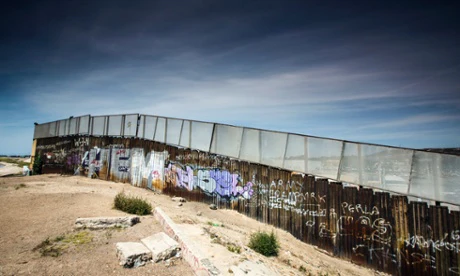Radical Cities: extracted in the Guardian

Tijuana: the edge of Mexico and the end of Latin America. A political equator that divides the global South and North; where the developing & developed worlds meet. The question is, how can the two influence each other?
 The Mexico-US border wall on the edge of the city of Tijuana. Photograph: Felix Clay
The Mexico-US border wall on the edge of the city of Tijuana. Photograph: Felix Clay
“Estoy al límite,” reads the graffiti in two-foot-high letters on the steel fence – I’m at the limit. This rusty wall is the edge of Mexico, and the end of Latin America. Driving along it, on a dirt road, the border is something of an anti-climax. Forget the fact that it looks like you could plough through this particular section with the right 4x4, the landscape around it is patchily inhabited and has all the hallmarks of a non-place. And yet this is the most significant line in the sand in the western hemisphere. On the other side, in the United States, is another universe.
Teddy Cruz points to the building next to us, a bullring. “It’s great,” he says, “the very last building in Latin America before you get to the US is a bullring.” Even though he has been studying this border zone for more than a decade, he seems to have lost none of his enthusiasm for it. Originally from Guatemala, Cruz is an architect and professor of public culture and urbanism at the University of California, San Diego. He is also the foremost theorist of the Tijuana-San Diego border in terms of what happens when the urban culture of the developing world collides with that of the developed world. Both analyst and provocateur, for him this frontier zone is fizzing with potential, and he is using it to try to redefine the architect’s role in making cities.
The border between Tijuana and San Diego is the busiest land crossing in the world. There are an estimated 300,000 crossings a day – that’s more than 100 million a year. Since 9/11 vast sums have been spent on hardening this membrane, making it less porous. And yet it is predicted that after 2050 non-Hispanic whites will become a minority group in the US. As Mike Davis wrote over a decade ago: “These are millennial transformations with truly millennial implications for US politics and culture.”
Tijuana is one of the fastest-growing cities in Mexico. With a population of nearly 2 million, coupled with San Diego it forms a transnational metropolitan region of more than 5 million. As the economies of these two cities are so closely linked, it would seem to make sense not to harden the divide but to embrace their symbiotic relationship. And that’s how it looks from San Diego City Hall, which recently opened a branch in Tijuana. The mayor’s office even prepared a bid for the 2024 Olympics to be hosted jointly by the two cities – an idea that the International Olympic Committee is not quite ready for.
In one of those speculative reports full of foreboding about our urban future, UN-Habitat has predicted that this century metropolises will start joining up like blobs of mercury, crossing international borders to form urban mega-regions. Tijuana-San Diego is an intriguing prospect because the border is not just national but forms part of an imaginary line dividing the global South and North, the developing and developed worlds. This is what Cruz calls the political equator. The question is how the two worlds on either side of it can influence each other?
Read the rest of this extract from Radical Cities in the Guardian.
Radical Cities: Across Latin America in Search of a New Architecture is now available to buy.